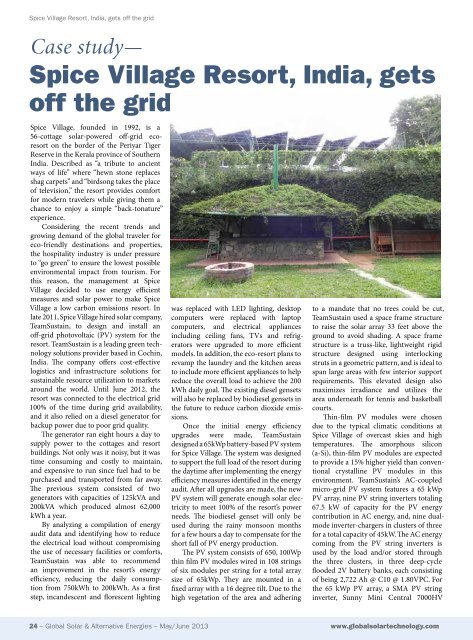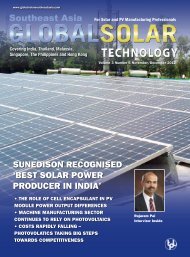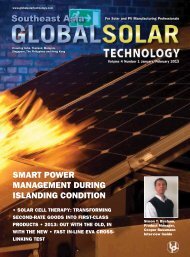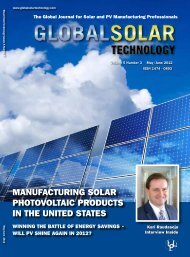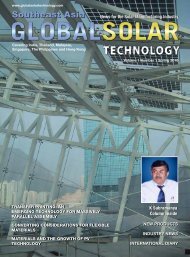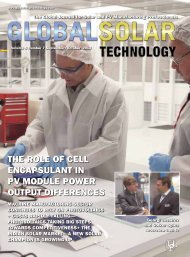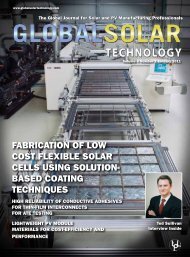Download the PDF - Global Solar Technology
Download the PDF - Global Solar Technology
Download the PDF - Global Solar Technology
Create successful ePaper yourself
Turn your PDF publications into a flip-book with our unique Google optimized e-Paper software.
Spice Village Resort, India, gets off <strong>the</strong> grid<br />
Case study—<br />
Spice Village Resort, India, gets<br />
off <strong>the</strong> grid<br />
Spice Village, founded in 1992, is a<br />
56-cottage solar-powered off-grid ecoresort<br />
on <strong>the</strong> border of <strong>the</strong> Periyar Tiger<br />
Reserve in <strong>the</strong> Kerala province of Sou<strong>the</strong>rn<br />
India. Described as “a tribute to ancient<br />
ways of life” where “hewn stone replaces<br />
shag carpets” and “birdsong takes <strong>the</strong> place<br />
of television,” <strong>the</strong> resort provides comfort<br />
for modern travelers while giving <strong>the</strong>m a<br />
chance to enjoy a simple “back-tonature”<br />
experience.<br />
Considering <strong>the</strong> recent trends and<br />
growing demand of <strong>the</strong> global traveler for<br />
eco-friendly destinations and properties,<br />
<strong>the</strong> hospitality industry is under pressure<br />
to “go green” to ensure <strong>the</strong> lowest possible<br />
environmental impact from tourism. For<br />
this reason, <strong>the</strong> management at Spice<br />
Village decided to use energy efficient<br />
measures and solar power to make Spice<br />
Village a low carbon emissions resort. In<br />
late 2011, Spice Village hired solar company,<br />
TeamSustain, to design and install an<br />
off-grid photovoltaic (PV) system for <strong>the</strong><br />
resort. TeamSustain is a leading green technology<br />
solutions provider based in Cochin,<br />
India. The company offers cost-effective<br />
logistics and infrastructure solutions for<br />
sustainable resource utilization to markets<br />
around <strong>the</strong> world. Until June 2012, <strong>the</strong><br />
resort was connected to <strong>the</strong> electrical grid<br />
100% of <strong>the</strong> time during grid availability,<br />
and it also relied on a diesel generator for<br />
backup power due to poor grid quality.<br />
The generator ran eight hours a day to<br />
supply power to <strong>the</strong> cottages and resort<br />
buildings. Not only was it noisy, but it was<br />
time consuming and costly to maintain,<br />
and expensive to run since fuel had to be<br />
purchased and transported from far away.<br />
The previous system consisted of two<br />
generators with capacities of 125kVA and<br />
200kVA which produced almost 62,000<br />
kWh a year.<br />
By analyzing a compilation of energy<br />
audit data and identifying how to reduce<br />
<strong>the</strong> electrical load without compromising<br />
<strong>the</strong> use of necessary facilities or comforts,<br />
TeamSustain was able to recommend<br />
an improvement in <strong>the</strong> resort’s energy<br />
efficiency, reducing <strong>the</strong> daily consumption<br />
from 750kWh to 200kWh. As a first<br />
step, incandescent and florescent lighting<br />
was replaced with LED lighting, desktop<br />
computers were replaced with laptop<br />
computers, and electrical appliances<br />
including ceiling fans, TVs and refrigerators<br />
were upgraded to more efficient<br />
models. In addition, <strong>the</strong> eco-resort plans to<br />
revamp <strong>the</strong> laundry and <strong>the</strong> kitchen areas<br />
to include more efficient appliances to help<br />
reduce <strong>the</strong> overall load to achieve <strong>the</strong> 200<br />
kWh daily goal. The existing diesel gensets<br />
will also be replaced by biodiesel gensets in<br />
<strong>the</strong> future to reduce carbon dioxide emissions.<br />
Once <strong>the</strong> initial energy efficiency<br />
upgrades were made, TeamSustain<br />
designed a 65kWp battery-based PV system<br />
for Spice Village. The system was designed<br />
to support <strong>the</strong> full load of <strong>the</strong> resort during<br />
<strong>the</strong> daytime after implementing <strong>the</strong> energy<br />
efficiency measures identified in <strong>the</strong> energy<br />
audit. After all upgrades are made, <strong>the</strong> new<br />
PV system will generate enough solar electricity<br />
to meet 100% of <strong>the</strong> resort’s power<br />
needs. The biodiesel genset will only be<br />
used during <strong>the</strong> rainy monsoon months<br />
for a few hours a day to compensate for <strong>the</strong><br />
short fall of PV energy production.<br />
The PV system consists of 650, 100Wp<br />
thin film PV modules wired in 108 strings<br />
of six modules per string for a total array<br />
size of 65kWp. They are mounted in a<br />
fixed array with a 16 degree tilt. Due to <strong>the</strong><br />
high vegetation of <strong>the</strong> area and adhering<br />
to a mandate that no trees could be cut,<br />
TeamSustain used a space frame structure<br />
to raise <strong>the</strong> solar array 33 feet above <strong>the</strong><br />
ground to avoid shading. A space frame<br />
structure is a truss-like, lightweight rigid<br />
structure designed using interlocking<br />
struts in a geometric pattern, and is ideal to<br />
span large areas with few interior support<br />
requirements. This elevated design also<br />
maximizes irradiance and utilizes <strong>the</strong><br />
area underneath for tennis and basketball<br />
courts.<br />
Thin-film PV modules were chosen<br />
due to <strong>the</strong> typical climatic conditions at<br />
Spice Village of overcast skies and high<br />
temperatures. The amorphous silicon<br />
(a-Si), thin-film PV modules are expected<br />
to provide a 15% higher yield than conventional<br />
crystalline PV modules in this<br />
environment. TeamSustain’s AC-coupled<br />
micro-grid PV system features a 65 kWp<br />
PV array, nine PV string inverters totaling<br />
67.5 kW of capacity for <strong>the</strong> PV energy<br />
contribution in AC energy, and, nine dualmode<br />
inverter-chargers in clusters of three<br />
for a total capacity of 45kW. The AC energy<br />
coming from <strong>the</strong> PV string inverters is<br />
used by <strong>the</strong> load and/or stored through<br />
<strong>the</strong> three clusters, in three deep-cycle<br />
flooded 2V battery banks, each consisting<br />
of being 2,722 Ah @ C10 @ 1.80VPC. For<br />
<strong>the</strong> 65 kWp PV array, a SMA PV string<br />
inverter, Sunny Mini Central 7000HV<br />
24 – <strong>Global</strong> <strong>Solar</strong> & Alternative Energies – May/June 2013 www.globalsolartechnology.com


